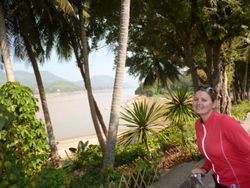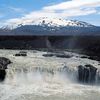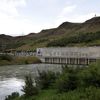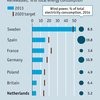25.10.2014 | 20:15
Orkuparadķs
Žjóšir heims bśa viš afar misjafnan kost ķ orkumįlum, og nęgir ķ žvķ sambandi aš bera saman Danmörku og Ķsland. Eitthvaš mun vera um olķu og gas ķ danskri lögsögu, en eina sjįlfbęra orkuvinnslan žar ķ landi er meš vindrafstöšvum og sólarhlöšum.
Įšur fyrr fór megniš af raforkuvinnslunni fram ķ olķukyntum raforkuverum. Eftir olķukreppuna 1973 var orkuverunum af kostnašarįstęšum breytt ķ kolakynt orkuver, og til aš draga śr losun CO2/MWh er nś veriš aš auka hlut gaskyntra orkuvera auk vindrafstöšva.
Į Ķslandi er orkumįlunum allt öšru vķsi variš. Um 1930 var Reykjavķk aš miklu leyti kynt meš kolum, og sżna ljósmyndir af höfušstašnum hann hulinn reyk- og sótmekki frį ófullkomum kolabruna į žessum tķma. Žį rišu Reykvķkingar į vašiš og hófu aš bora eftir heitu vatni og dęla žvķ upp ķ mišlunargeyma į Öskjuhlķš, žašan sem žaš var leitt ķ öll hśs höfušstašarins, og hann varš fyrir vikiš hreinasta borg Evrópu, og žótt vķšar vęri leitaš, žó aš sķšar hafi heldur sigiš į ógęfuhlišina vegna mikillar fartękjaumferšar og gasmengunar frį gufuorkuveri į Hellisheiši. Žessi mengun stendur til bóta, žvķ aš rafknśnum bifreišum mun fjölga og virkjunarfyrirtękin eru aš rįša bót į mengunarvandanum.
Ķsland bżr ekki yfir mjög miklum nįttśrulegum orkulindum ķ samanburši viš żmsar žjóšir Evrópu, t.d. Noršmenn, sem geta framleitt ferfalt meiri raforku en Ķslendingar, žegar allir virkjanakostir hafa veriš nżttir, žar sem nżtingargildiš er tališ meira en verndargildiš. Hins vegar eru meiri sjįlfbęrar virkjanlegar orkulindir į hvern mann į Ķslandi en ķ öšrum löndum Evrópu, og Ķsland er eitt af aušugustu rķkjum heims, reiknaš ķ nżtanlegri sjįlfbęrri orku į mann.
Orkunotkun Ķslendinga skiptist žannig įriš 2013:
- Jaršhiti: 170,7 PJ eša 68 % ;29 % af raforkuvinnslu
- Vatnsorka: 46,3 PJ eša 18 %; 71 % af raforkuvinnslu
- Olķa: 30,4 PJ eša 12 %
- Kol: 4,0 PJ eša 2 %
Ķsland er eitt örfįrra landa ķ heiminum, žar sem öll raforkuvinnslan į sér staš meš sjįlfbęrum hętti, og okkur veršur ekki skotaskuld śr aš śtrżma oķunotkun meš rafmagni, žegar tęknin mun leyfa žaš, en fregnir berast nś af žróun įlrafgeyma, sem henta munu fartękjum vel, žvķ aš hlutfalliš kWh/kg er tiltölulega hįtt og langdręgni į milli endurhlešslna mun vera um 1000 km.
Sjįlfbęru orkulindir Ķslands, sem mest kvešur aš viš raforkuvinnslu, fallvötn og jaršgufa, eru samkeppnihęfar viš orkulindir annarra landa meš žvķ aš nżta žęr hér innanlands og flytja afurširnar utan meš skipum, en žęr geta ekki keppt viš gasorkuver og kjarnorkuver, ef orkan er flutt beint utan meš sęstreng.
Fyrrverandi prófessor viš Verkfręšideild Hįskóla Ķslands og sķšar Orkumįlastjóri, Jakob Björnsson, rafmagnsverkfręšingur, žreyttist ekki į aš rita fręšandi greinar ķ Morgunblašiš um žaš, aš bezta framlag Ķslendinga til varnar upphitunar andrśmsloftsins vegna koltvķildislosunar eldsneytiskyntra raforkuvera vęri aš laša orkukręfan išnaš til landsins. Žetta hefur tekizt sęmilega.
Vķkur nś sögunni til Žżzkalands. Jolanta Zalpyté frį Lithįen hefur samiš Meistaraprófsritgerš um "Breytingastjórnun į heimsvķsu" eša "Global Change Management" viš Eberswalde hįskóla sjįlfbęrrar žróunar ķ Žżzkalandi, žar sem hśn starfar sem sérfręšingur ķ endurnżjanlegri orku, hagvexti og žróun sjįlfbęrrar orku m.m.. Jolanta hefur komiš auga į styrk Ķslands į žessu sviši, og landiš uppfyllir öll skilyrši žess aš vera flokkaš sem orkuparadķs, sem meš samstarfi viš alžjóšleg fyrirtęki getur lagt sitt aš mörkum til aš draga śr eldsneytisbrennslu og mengun ķ heiminum. Jolanta hefur veitt góšfśslegt leyfi til birtingar śrdrįttar hér śr téšri ritgerš. Fyrst fį lesendur smjöržefinn af ritgeršinni meš örstuttri žżšingu į ķslenzku:
"Žrįtt fyrir gnótt endurnżjanlegrar orku veršur stjórnmįlalegur stöšugleiki aš vera fyrir hendi ķ viškomandi landi, svo aš unnt sé aš flokka žaš sem "orkuparadķs". Til aš laša til sķn fjįrfestingar verša rķki aš vera stjórnmįlalega stöšug (žaš er ekki naušsynlegt fyrir "mengunarparadķsir"). Ķsland, sem tekiš er sem dęmi um land, sem uppfyllir skilyrši um "orkuparadķs", sannaši, aš stjórnmįlalegur stöšugleiki er lykilatriši fyrir hagžróunina. Įriš 2008 varš Ķsland fyrsta fórnarlamb hinnar alžjóšlegu fjįrmįlakreppu. Žrķr meginbankar landsins féllu. Ķsland varš fyrst žróašra rķkja til aš sękja um ašstoš Alžjóša gjaldeyrissjóšsins į sķšustu 30 įrum (Jón Danķelsson, 2013). Landiš hjarnaši fljótlega viš. Réttar stjórnvaldsįkvaršanir framköllušu hagvöxt, og Ķsland er nś vķša žekkt og dįš fyrir aš nota įrangursrķk mešul viš aš fįst viš fjįrhagskeppuna." 
Mynd af höfundi ritgeršarinnar er hér til hęgri. Ritgeršarśrdrįtturinn kemur betur fram og meš öllum myndum ķ fylgiskjalinu nešst.
„ENERGY HAVENS“: TOWARDS A SUSTAINABLE ECONOMIC FUTUREA study based on the example of Iceland Jolanta ŽalpytÄ—Master Study Program Global Change ManagementFaculty of Forest and Environment, Eberswalde University for Sustainable Development There are many concerns on how to enhance environmental policies through participating in the international market with opened borders. For many years already a strong cooperation with countries with lower environmental regulations developed between the United States of America and some Western European countries. This development has brought forward a raise of standards in environmental policies across the world but a big gap still prevails in the regulations between developed and developing countries. Some environmental economists claim that trade flows across countries with different environmental regulations may create the “pollution haven” effect and a “race to the bottom” in environmental standards. The term “pollution havens” is used when pollution intensive manufacturing is relocated from developed to developing countries where environmental regulations are assumed to be less stringent (Nahman & Antrobus, 2005). Globalization and international cross-border cooperation also play a vital role for international tax regimes. Different fiscal policies in one country influence the economic situation in others, even countries located far away. Companies and individual persons use the possibility of increased capital mobility and choose locations where the tax burden is lower. These locations are called “tax havens”. Similar to “pollution havens”, “tax havens” can create a “race to the bottom” in the collective tax base. The similarity of this terminology raises the question what makes a country a haven. Since the globalised market is being challenged by an increasing demand for energy and the energy supply is becoming one of the main cost factors in the production process for many industries, the research analysed a new definition of the term “energy havens”. The term “energy havens” describes countries which have a big potential of renewable energy creation that can be provided to “power-hungry” consumers/energy-intensive enterprises. This is the aspect which differentiates them from the previously mentioned “pollution havens” because the use of traditional energy sources to offer industries a cheap energy supply would result in the “pollution haven” effect. The exploitation of renewable energy sources has to be feasible and ecologically desirable in order not to cause harm to nature and "pollute" the environment. The main target groups of this master thesis are energy-intensive industries and the academic audience whose interest is the future energy market condition. The research conducted focuses on electricity, with production cost as the main factor.Electricity produced from fossil fuels is not favorable due to the unsecure conditions for future energy markets (import from politically unstable regions) as well as certain risks and impacts on the environment (e.g. oil spills, health risks from fossil fuel burning). Mainly, the origin of resources is from undesirable regions (such as the desert in Saudi Arabia) where the energy infrastructure can provide many challenges. Also, exploitation areas are changing over time. This kind of energy source does not attract many investments because it cannot promise a secure and infinite energy supply for the future. Conversely, renewable energy can help to decouple the correlation between the increasing energy demand and the negative impact on climate and nature.The leading example of an “energy haven” generating electricity from renewable energy is Iceland. The country can provide more electricity than required by all of its residents, businesses and industries. There are already many foreign companies investing in Iceland and relocating their facilities there. As Figure 1 shows, a steep rise in energy intensity since 2005 is due to an increased amount of energy-intensive companies migrating to the country (Nordic Energy Research, 2013).
Figure 1. Energy intensity in major economies 1990-2011
Source: Nordic Energy Research (2013).Interviews with foreign companies in Iceland were chosen as a method of receiving first-hand information about the decisions on the location. Figure 2 presents the outcome of a qualitative analysis of the questionnaires. This shows why Iceland was chosen as a leading “energy haven”.Figure 2. Industry perspectives on Iceland as a priority location
Note: the figure was prepared by the author based on data collected from the interviewed companies. Potential “energy havens”Table 1 shows the similarities and differences of two country groups considered “havens”. The criteria explain how “havens” distinguish themselves from other countries. The set of criterions is used as a primary tool to determine “energy havens”. The identified criteria in the right column illustrate the necessary conditions for a country to become an “energy haven”. Iceland was chosen as a country which best fulfills the listed criteria.Criteria | “Pollution havens” | “Tax havens” | “Energy havens” |
Pre-existing condition | International cooperation | International cooperation | |
Resources | No necessary physical resources | Abundance of renewable energy | |
Policy | Lower environmental standards | Lower tax rates | Lower energy costs |
Conditions | Lack of data availability and publicity | Promotion of environmentally-friendly production possibilities | |
Incentive for companies | Lax or non-enforced environmental regulations | Lenient requirements for establishing new business entities | Long-term contracts for a stable and cheap energy supply |
Requirements | Low political control of production facilities | Political stability and security of financial assets | Political stability, good infrastructure and business-friendly environment |
Advantages for companies | More savings due to lower pollution abatement costs | More savings due to a lower tax burden | More savings due to lower energy costs |
Results | Higher FDI inflows | Higher FDI inflows | |
Effect on other countries | Enforcement of lower environmental standards | Enforcement of lower tax rates | Enforcement of lower energy costs |
Limits | International agreements | Energy exports | |
Table 1. Criteria for a country to become a “haven”
Note: the table is prepared by the author. The criteria set for “energy havens” is determined by the author based on the example of Iceland (partly from the empirical results of the questionnaire) using the analogies of “tax and pollution havens”. Positive aspects are indicated in green, negative aspects are indicated in red, and aspects which cannot be assigned according to the author were left uncoloured.Despite an abundance of renewable energy another important factor categorising a country as an “energy haven” is political stability. In order to attract investments countries have to be politically stable (not in the case of “pollution havens”). Iceland, taken as an example for satisfying the listed criteria for “energy havens”, proved that political stability is a key factor determining a country’s development. In 2008, Iceland was the first country to suffer casualties on account of the Global Financial Crisis. All three banks of the country collapsed. Iceland was the first developed country requesting assistance from the International Monetary Fund in the last 30 years (Danielsson, 2013). But the country quickly recovered. Correct policy decisions nurtured economic growth and Iceland is now widely discussed and renowned for applying successful techniques in dealing with the financial crisis.This research identified nine countries around the globe which can be considered “energy havens”, Iceland being the leading candidate (others being Norway, New Zealand, Canada, Sweden, Bhutan, French Guiana, Costa Rica and Latvia). The selection of countries was based on five different criteria: the share of renewable energy in their electricity generation, the Corruption Perceptions Index, the Political Risk Index, the Global Peace Index and the Human Development Index. These criterions and their individual estimated value demonstrated the potential for sustainable energy development in each country, as well as necessary improvements which need to be undertaken in order to become an “energy haven”. The study also found 3 “energy haven” jurisdictions: Facebook, Inc. in Luleå (Sweden), Ford Liard in Northwest Territories (Canada) and Google, Inc. in Hamina (Finland). Figure 3 marks the locations of “energy havens” and “energy haven” jurisdictions on a world map.Figure 3. “Energy havens” and “energy haven” jurisdictions
Policy incentives supporting the existence of “energy havens”One criterion listed in Table 1 implies that the potential existence of “energy havens” may incline other countries to reduce their energy (electricity) prices. Germany is a good example when looking for a proof of the existence of “energy havens”. Germany’s competitiveness is being threatened by increasing energy costs. This is a result of the so called “Energiewende”, a transition towards a low-carbon energy economy while giving out subsidies for renewable energy (Folkerts-Landau, 2013). It is correct that this transition can potentially guarantee a long-term competitive solution for Germany, but in the meantime the cost of electricity has noticeably risen. Due to an increase of electricity prices Germany’s popularity as a production location for industries could decrease in the future. To prevent this from happening, energy-intensive enterprises are exempt from the Renewable Energy Sources Act levy and pay significantly less for electricity. This is one of the ways that Germany is trying to prevent its energy-intensive companies from moving to “energy havens”.A different approach than Germany with its nuclear power phase-out is taken by Finland, which has created a competitive electricity market for energy-intensive ventures allowing them to continue building nuclear power plants. Compared to the electricity gained from fossil fuels, the costs of nuclear power are predictable. It remains to be seen whether or not this promising strategy implemented in Finland yields any results for furthering sustainable economic growth since power prices remain relatively low and the level of emissions is comparably lower than when using other conventional energy sources (coal, oil, gas, etc.). Finland was not classified as an “energy haven” in this thesis since nuclear power is widely believed to be non-renewable. The disposal of atomic waste and its implications are still considered a great potential burden for future generations. It is difficult to estimate costs which can occur even thousands of years after its initial use. The latent security threat is another problem especially in times of global terrorism. Key limitations of the studyThe term “haven” refers to a location which provides an attractive investment climate and gives incentive to locate your activities there. The possibility to export energy from an “energy haven” would partially eliminate the given definition. But this is currently a criterion which is not very feasible yet. A good example of a failure to export energy is the “Desertec” project. An interconnector marine cable for power transmission situated at the bottom of the ocean between Iceland, the United Kingdom (UK) and mainland Europe is planned. This is a long-term project because the production and installation of this cable and other related tasks must be very carefully planned out. If the project is approved it is expected to be completed by 2020 at the earliest (Landsvirkjun, 2013). This thesis promotes the idea that industries could move to “energy havens” if electricity were a main production cost factor for them. When electricity becomes a good that can easily be shipped anywhere, there will be no more “energy havens” like the ones described earlier but “energy production havens” would develop instead. References1. Nahman, Anton; Antrobus, Geoff (2005): Trade and the environmental Kuznets curve: is Southern Africa a pollution haven? In South African Journal of Economics 73 (4), pp. 803–814. Available online at http://onlinelibrary.wiley.com/doi/10.1111/j.1813-6982.2005.00055.x/pdf, checked on 2/18/2013.2. Nordic Energy Research (2013): Increasingly energy efficient economies. Nordic Energy Research. Available online at http://www.nordicenergy.org/thenordicway/topic/energy-systems-2/, updated on 4/12/2013, checked on 5/22/2013.3. Danielsson, Jon (2013): Iceland’s post-Crisis economy: A myth or a miracle? Available online at http://www.voxeu.org/article/iceland-s-post-crisis-economy-myth-or-miracle, checked on 8/11/2013.4. Folkerts-Landau, David (2013): Energiewende 2.0 - don't risk competitiveness. Deutsche Bank. Available online at https://www.dbresearch.com/PROD/DBR_INTERNET_EN-PROD/PROD0000000000324468/Energiewende+2_0+-+don't+risk+competitiveness.PDF, updated on 11/26/2013, checked on 3/21/2014.5. Landsvirkjun (2013): Submarine cable to Europe. Landsvirkjun. Available online at http://www.landsvirkjun.com/ResearchDevelopment/Research/SubmarineCabletoEurope/, checked on 5/13/2013. This publication is based on the master thesis written by Jolanta ŽalpytÄ—. Jolanta ŽalpytÄ— has a bachelor degree in Economics (Vytautas Magnus University, Lithuania) and recently completed her M. Sc. degree in Global Change Management (Eberswalde University for Sustainable Development, Germany). Born in Lithuania and currently based in Germany, she specialises in renewable energy, economic growth, sustainable energy development and others.
Meginflokkur: Bloggar | Aukaflokkar: Umhverfismįl, Višskipti og fjįrmįl, Vķsindi og fręši | Facebook
 "Energy Havens": Towards Sustainable Economic Future
"Energy Havens": Towards Sustainable Economic Future agbjarn
agbjarn
 alit
alit
 bjarnihardar
bjarnihardar
 diva73
diva73
 duddi9
duddi9
 eeelle
eeelle
 einarbb
einarbb
 fannarh
fannarh
 fullvalda
fullvalda
 fun
fun
 gattin
gattin
 gerdurpalma112
gerdurpalma112
 gudni-is
gudni-is
 gustafskulason
gustafskulason
 krissiblo
krissiblo
 liljabolla
liljabolla
 loftslag
loftslag
 nr123minskodun
nr123minskodun
 ollana
ollana
 ragnargeir
ragnargeir
 redlion
redlion
 rosaadalsteinsdottir
rosaadalsteinsdottir
 samstada-thjodar
samstada-thjodar
 siggisig
siggisig
 sisi
sisi
 thjodarheidur
thjodarheidur
 tilveran-i-esb
tilveran-i-esb
 valli57
valli57
 thjodfylking
thjodfylking
 biggilofts
biggilofts
 contact
contact
 elben
elben
 ingolfursigurdsson
ingolfursigurdsson
 johanneliasson
johanneliasson
 thjodarskutan
thjodarskutan
 arkimedes
arkimedes
 fullveldi
fullveldi
 tsiglaugsson
tsiglaugsson









Athugasemdir
Takk fyrir góšan og įhugaveršan pistil Bjarni.
Įgśst H Bjarnason, 26.10.2014 kl. 12:30
Sęll, Įgśst;
Mér finnst sjónarhorn žeirra ķ hįskóla sjįlfbęrrar žróunar ķ Eberswalde vera įhugavert fyrir Ķslendinga. Žaš er lķka alltaf fróšlegt aš fį erlent sjónarhorn į žróun mįla hér. Kvešur žį oft viš annan tón en viš erum vön hérlendis. Jolanta bendir į, aš Žjóšverjar hafa undanžegiš orkukręfan išnaš sķnum hįum sköttum į raforkuna. Žar segir hśn įhrifa orkuparadķsanna gęta, žvķ aš aušvitaš leitar alžjóšlegur išnašur žangaš, sem starfsskilyrši hans eru hagstęšust. Žetta žurfa žeir aš hafa ķ huga, sem veršleggja raforkuna hérlendis.
Bjarni Jónsson, 26.10.2014 kl. 13:40
Bęta viš athugasemd [Innskrįning]
Ekki er lengur hęgt aš skrifa athugasemdir viš fęrsluna, žar sem tķmamörk į athugasemdir eru lišin.